Volume 24, Issue 2

Regional Overview
May — August 2022Washington “Pivots” to Asia
The Biden administration has rediscovered Asia. And, for better or worse, so has the US Congress. While the administration’s national security documents (or at least their unclassified sneak previews) have identified the Indo-Pacific as a priority theater vital to US national security and China as “our most consequential strategic competitor and the pacing challenge,” Europe continues to steal headlines and the lion’s share of the administration’s (and international media’s) attention, thanks to Vladimir Putin and his unwarranted (and so far unsuccessful) invasion of Ukraine.
While many eyes remain on Putin’s war (and NATO’s US-led solid support for Kyiv), this reporting period saw President Biden finally make his first trip to Asia to visit longstanding US allies and attend the second in-person Quadrilateral Security Dialogue (“Quad”) Summit. Prior to his trip, Biden hosted his first US-ASEAN Summit in Washington. Meanwhile Secretary of Defense Lloyd Austin and Secretary of State Antony Blinken were both in Southeast Asia, respectively for the Shangri-La Dialogue and for various ASEAN-driven ministerials. These administration trips were largely overshadowed, however, by US Speaker of the House Nancy Pelosi’s controversial trip to Taiwan, the first by a House Speaker in 25 years, which was sure to—and clearly did—draw Beijing’s ire.
The US administration also (finally) put some meat on the bones of its Indo-Pacific Economic Framework, even though (like Obama’s earlier pivot) the trade and economic dimension of the administration’s Indo-Pacific Strategy remains the least developed. The military dimension of the strategy was much more in evidence, highlighted by the Rim of the Pacific (RIMPAC) exercise and a number of other multilateral training events throughout the region. Multilateralism will continue to capture the headlines as we move into the year’s third trimester with the ASEAN-driven East Asia Summit and Asia-Pacific Economic Cooperation (APEC) Leaders’ Meeting sharing pride of place with the Indonesia-hosted G20 Summit.

US - Japan
May — August 2022Abe’s Legacy and the Alliance Agenda
It was a busy summer for the United States and Japan. President Joe Biden visited Asia, stopping first in Seoul to meet new South Korean President Yoon Suk Yeol, and then spending two days in Tokyo for a bilateral summit with Prime Minister Kishida Fumio and a follow-on meeting with the two other leaders of the Quad, Indian Prime Minister Narendra Modi and Australia’s newly elected prime minister, Anthony Albanese. Biden announced his Indo-Pacific Economic Framework in Tokyo with Kishida by his side. Economic security legislation in both Japan and the United States revealed the unfolding strategic calculations for the alliance. National efforts to enhance economic productivity and resilience included efforts to ensure reliable supply chains for Japanese and US manufacturers as well as the desire for greater cooperation among the advanced industrial economies to dominate the next generation of technological innovation. State investment in attracting semiconductor suppliers to Japan and the United States demonstrate the urgency with which both governments seek to diminish reliance on critical technology imports.
Despite all the diplomatic planning that accompanied these developments, the summer was not without surprises. In Japan, the sudden death of former Prime Minister Abe Shinzo, at the hand of a lone gunman, shocked a nation known for its relatively low rate of gun violence. Across the globe, leaders praised Abe’s statesmanship and his strategic vision—his ability to meet Japan’s moment of challenge as the rules-based order was under threat.
Only weeks later, the United States and China found themselves in a high-stakes military standoff over Taiwan. US Speaker of the House Nancy Pelosi rescheduled her Asia tour after having to cancel it in April due to COVID-19. Her itinerary leaked, and her intention to visit Taiwan drew China’s ire. A top commentator for the Global Times tweeted that China’s People Liberation Army (PLA) had the right to shoot down Pelosi’s plane if she did. And a highly charged demonstration of Chinese military power ensued. The PLA exercises conducted after her departure directly involved Japan as missiles landed in its exclusive economic zone (EEZ). The United States ensured that its military was close at hand to dissuade miscalculation.

US - China
May — August 2022US-China Relations Sink Further Amid Another Taiwan Strait Crisis
Nancy Pelosi’s August visit to Taiwan—the first visit by a speaker of the US House of Representatives in 25 years—was met by a strong response from China that included provocative military exercises, punitive economic measures against Taiwan, and the suspension and cancellation of a series of dialogues with the United States. Just prior to Pelosi’s visit, Presidents Joe Biden and Xi Jinping held their fifth virtual conversation since Biden’s inauguration. Secretary of State Antony Blinken delivered a comprehensive speech on the administration’s China strategy in late May. Biden officials debated whether to lift some of the tariffs imposed on China under the Trump administration, but as of the end of August, there was no decision to do so. Human rights remained on the US agenda, with statements issued on the anniversary of the June 4, 1989 Tiananmen massacre and on the 25th anniversary of the handover of Hong Kong to the PRC, and a ban imposed on imports into the US of products made by forced labor in Xinjiang. US Secretary of Defense Lloyd Austin held his first face-to-face meeting with Chinese Defense Minister Wei Fenghe at the Shangri-La Dialogue in Singapore.

US - Korea
May — August 2022Split Images
Lopsided: such was the state of US relations with the two Koreas during May-August 2022. The Washington-Seoul axis mostly flourished on the military/security, diplomatic, economic, and cultural fronts, while Washington and Pyongyang deepened doldrums whose depths had been plumbed in prior reporting periods. For the former, the most significant items included the May inauguration of conservative South Korean President Yoon Suk Yeol and quick follow-on summit with US President Joe Biden, increasing trilateral US-South Korea-Japan cooperation, a raft of announcements on US-South Korea economic and technology cooperation, the resumption of field maneuvers in US-South Korea joint military exercises, and South Korea’s continuing growth as a serious middle power player in foreign policy, including stepped-up engagement with NATO. In US-North Korea relations, a COVID-19 outbreak failed to lead the Kim Jung Un regime to open up to outside humanitarian assistance, as Pyongyang remained content to keep borders mostly closed and allow the virus to course through the population with only basic prophylactic measures. On the positive side, Pyongyang’s hyperactive missile testing in spring slowed during summer, and a feared (yet still expected) seventh nuclear test failed to materialize.
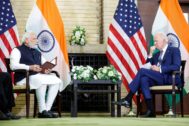
US - India
May — August 2022Relations at 75: Hawaii to the Himalayas
This chapter was made possible through a grant from the Hindu American Foundation
Like the saying, “after the storm comes the calm,” US-India relations witnessed four months of productive talks, cooperation, and collaboration. This contrasted with the previous trimester, mired as it was by Cold-War era differences brought about by the Russia-Ukraine conflict. There were thriving Indo-Pacific synergies and the decline of Cold War-era differences. The US and India continued and expanded cooperation on a wide array of regional and global issues, such as climate change, supply chains, and the Sri Lankan crisis. They solidified their defense partnership from Hawaii to the Himalayas through navy and military exercises. The US turned down pressure on India over Russian oil purchases and recalibrated the dialogue to address other pressing challenges. They did not avoid tough conversations, however. India reinforced its view of the US and other Western nations’ role in keeping the Indo-Pacific a safer and more open region.
While minor differences remain, the two democracies found common ground in addressing what they both consider to be the most pressing challenges: China’s belligerent actions and the existential threat of climate change. Their targeted actions to address the two issues became more overt and coordinated. Through the launch of initiatives such as the Indo-Pacific Economic Framework (IPEF), the Biden administration reentered the Asian economic architecture—though not through a trade agreement—bringing otherwise-hesitant economies, including India, into the fold.
Domestically, Biden and Modi were both preoccupied with amending historic injustices and preparing their societies and economies for 21st century challenges.

US - Southeast Asia
May — August 2022Washington Revs Up Diplomacy with Southeast Asia
The Biden administration’s diplomatic campaign in Southeast Asia kicked into high gear in the late spring and continued through the summer. On May 12-13 President Biden co-hosted, with Cambodian Prime Minister Hun Sen as the 2022 ASEAN chair, the first-ever US-ASEAN Special Summit to be held in Washington, DC. US relations in the region were also boosted when the Biden administration launched the long-awaited Indo-Pacific Economic Framework (IPEF) on May 23; seven Southeast Asian countries indicated interest in joining, although few are likely to accede to all four pillars of the framework in the near-term. Two Cabinet officials made visits to two US treaty allies: Secretary of Defense Lloyd Austin to Thailand in June and Secretary of State Anthony Blinken to the Philippines in August. Notwithstanding continuing differences over human rights, the visits served to reaffirm the bilateral alliances. However, global and regional tensions remained high, over the persistent crisis in Ukraine; brinksmanship in the Taiwan Straits; and the internal conflict in Myanmar which has only deteriorated further. These pressures only divided ASEAN further as the region looks ahead to a trifecta of international meetings—APEC, East Asia Summit, and the G20—in the fall.
Political activity was also at high levels, with elections in the Philippines; a surprise move by the Constitutional Court of Thailand to suspend Prime Minister Prayuth Chan-ocha; and a prison sentence for former Malaysian Prime Minister Najib Razak. In Thailand, Cambodia, Malaysia, Indonesia and possibly Myanmar, current political dynamics will help set the stage for elections in 2023 and 2024.
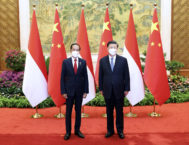
China - Southeast Asia
May — August 2022Countering US Initiatives, Taiwan Crisis Complications
Chinese enhanced activism in Southeast Asia in this reporting period focused on countering Biden administration efforts to enhance influence in the Indo-Pacific. The Chinese government intensified its depiction of the United States as disrupting regional order and portraying itself as the regional stabilizer. Beijing’s effort faced complications and uncertain prospects as Chinese military forces in August launched large-scale provocative shows of force amid strident media warnings targeting the United States over Taiwan.
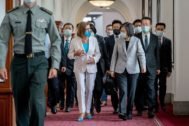
China - Taiwan
May — August 2022Pelosi’s “Ironclad Commitment” or “Political Stunt” Leads to Crisis and Promises Instability in the Taiwan Strait
Between May 1 and Sept. 1, tensions between Taiwan and China exploded in ways few anticipated but were in retrospect the culmination of well-established dynamics. The US once again was right in the middle. On Aug. 2, US Speaker of the House Nancy Pelosi arrived in Taiwan, which Taiwan’s government celebrated as the most important visit in at least 25 years by a US politician. She promised Taiwan President Tsai Ing-wen that US support for Taiwan’s security would remain “ironclad.” On Aug. 4, the day after Pelosi departed Taiwan, China signaled its displeasure by conducting the most extensive military exercises ever conducted near Taiwan, closer to the island than any before, and launching ballistic missiles over Taiwan’s capital to land in waters east of the island. Throughout these exercises, the Chinese, Taiwan, and US militaries avoided any interactions that might have provoked confrontation. On Aug. 10, the Chinese military announced that the exercises had concluded, achieving their objectives, but that the military would continue its activities around Taiwan.
This crisis occurred three months after US Secretary of State Antony Blinken delivered a long-awaited speech on US China policy, claiming that policy toward Taiwan and China, and the US commitment to peaceful resolution of any disputes between them, remained unchanged. China rejected Blinken’s claims of US consistency and insisted that Washinging was hollowing out its commitment to respect Beijing’s position as the only legal government of China, including Taiwan. China expressed particular anger at President Biden’s pledges to defend Taiwan and at the continuing series of high-level US officials visiting Taiwan. Beijing warned it would react harshly if Pelosi visited Taiwan, as she had promised to do. She visited, and China reacted, calling her visit a “political stunt.” China laid out its familiar claims to Taiwan in a celebration of the 30th anniversary of the 1992 consensus and again in its third White Paper on cross-Strait relations. All this comes as Chinese commentators repeat expectations that the 20th Congress of the Chinese Communist Party, scheduled for this fall, will reaffirm the party’s tough Taiwan policy.
Largely obscured by these dramatic developments, Taiwan continued to expand its legitimacy as a constructive international actor, attracting more public support from major international actors beyond the US, such as the G7, the European Union, the United Kingdom, Australia, Japan, and South Korea.
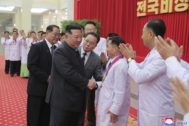
North Korea - South Korea
May — August 2022An Inauspicious Start
On May 10 Yoon Suk Yeol took office as ROK president, and rapidly lost popularity. While talking tough on North Korea, he also offered aid to fight COVID-19—but was ignored. His “audacious plan,” wholly unoriginal, to reward Pyongyang materially if it denuclearizes, had very little detail. For months the DPRK did not even mention Yoon. In late July Kim Jong Un sharply warned him against any pre-emptive strike. In August, his sister Kim Yo Jong put the boot in: ludicrously blaming materials sent by ROK activists for bringing COVID-19 into the DPRK, savaging Yoon’s proposal as insulting and unoriginal, and saying the North will never talk to him. At home, meanwhile, the new government chose to reopen two contentious inter-Korean episodes from the recent past, seemingly to punish its predecessor’s policies. It was hard to see how good could come of that, or to hold out hope for any thaw on the peninsula.
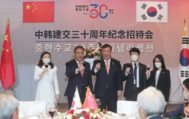
China - Korea
May — August 2022A Muted 30-Year Anniversary
Beijing and Seoul marked 30 years of diplomatic ties on Aug. 24 as South Korea transitioned to a new administration under President Yoon Suk Yeol, who took office in May. Although early high-level exchanges reaffirmed partnership, the two leaderships confront growing pressures from US-China competition, economic uncertainty, and public hostility. Domestic priorities in China in light of the 20th Party Congress and South Korea’s shift to conservative rule amplify these concerns. The impact of US-China rivalry on the China-South Korea relationship extends from security to economic coordination, including approaches to THAAD and global supply chains, and export competition, especially in semiconductors, challenges new Xi Jinping-Yoon economic agreements. Moreover, public hostility is strongest among South Korea’s younger generation, raising pessimistic prospects for future China-South Korea ties.
Despite mixed signals, false starts, and the continued absence of leader-level meetings marking the recovery of economic ties between China and North Korea, geopolitical developments have pushed the two countries closer together. Such engagement features mutual reinforcement of each other’s positions on issues of vital interest and solidarity in response to US policies.

Japan - China
May — August 2022Few Positive Signs and Much Negativity
The tone of China-Japan relations became more alarmist on both sides with long-anticipated plans to commemorate the 50th anniversary of the normalization of diplomatic relations still clouded with uncertainty. Several related events were canceled or postponed sine die.
Internationally, Prime Minister Kishida was exceptionally active, attending meetings of the Quad, the G7, NATO, and Shangri-La Dialogue, where he delivered the keynote address. A common theme was attention to a Free and Open Pacific (FOIP) and the need for stability in the region, both of which Beijing sees as intended to constrain China. At NATO, Kishida met with US and South Korean representatives for their first trilateral meeting in nearly five years and suggested the possibility of joint military exercises.
Meanwhile, China continued pressure on Taiwan and the contested Diaoyu/Senkaku Islands. Although Foreign Minister Wang Yi and State Councillor Yang Jieqi were active internationally, Xi Jinping himself has not ventured outside the Chinese mainland since January 2020 save for a brief, tightly controlled visit to Hong Kong, which is unquestionably part of China. Speculation ranged from concern with his health to worries that he might be toppled by unnamed enemies—who these enemies are and what degree of influence they wield are the topics of much discussion, since Xi has through selective arrests of potential rivals and the country-wide imposition of his thoughts, effectively silenced public expression of dissident opinions.
After former Prime Minister Abe was assassinated on July 8 in an incident unrelated to foreign policy, the Chinese government sent condolences, though no Chinese representative attended the wake. A state funeral is to be held in the fall, with much speculation on who will represent the PRC.

Japan - Korea
May — August 2022The Passing of Abe and Japan-Korea Relations
How might the passing of former Prime Minister Abe Shinzo impact Tokyo’s approach to Seoul? This unexpected turn of events loomed large in the minds of many who have been cautiously optimistic that Japan and South Korea would take steps toward a breakthrough in their stalled relations. In our last issue, we discussed how this summer could provide good timing for Seoul and Tokyo to create momentum in this direction after Yoon Suk Yeol’s inauguration as president in South Korea and the Upper House election in Japan. However, the results from this summer were mixed. Seoul and Tokyo have not yet announced whether Yoon and Kishida will hold a summit any time soon. Both leaders ended the summer juggling domestic politics amid declining approval ratings. However, there were some meaningful exchanges between the two governments, signaling that both sides were interested in improving relations.
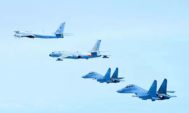
China - Russia
May — August 2022Embracing a Longer and/or Wider Conflict?
Unlike in 1914, the “guns of the August” in 2022 played out at the two ends of the Eurasian continent. In Europe, the war was grinding largely to a stagnant line of active skirmishes in eastern and southern Ukraine. In the east, rising tension in US-China relations regarding Taiwan led to an unprecedented demonstrative use of force around Taiwan. Alongside Moscow’s quick and strong support of China, Beijing carefully calibrated its strategic partnership with Russia with signals of symbolism and substance. Xi and Putin directly conversed only once (June 15). Bilateral trade and mil-mil ties, however, bounced back quickly thanks to, at least partially, the “Ukraine factor” and their respective delinking from the West. At the end of August, Mikhail Gorbachev’s death meant so much and yet so little for a world moving rapidly toward a “war with both Russia and China,” in the words of Henry Kissinger.

Australia-US/East Asia
September 2021 — August 2022Australia’s New Government: Climate, China and AUKUS
Australia has changed government and the political war over climate change draws to a close after raging for 15 years. The new Labor government led by Anthony Albanese promises continuity on foreign and defense policy, delivered with a different tone. In the government’s first 100 days, it chipped some ice from the frosty relationship with China. Ending a Beijing ban on meetings with Australian ministers that was in its third year, Chinese ministers had face-to-face talks with Australia’s foreign minister and defense minister. Albanese’s observation that dealing with China will continue to be difficult was demonstrated by a diplomatic duel in the South Pacific, as Canberra pushed back at Beijing’s ambition for a greater security role in islands. Two major defense announcements are due in the first months of 2023: the plan for an Australian nuclear submarine, based on the AUKUS agreement with the US and UK, plus a re-set of Australia’s military and strategic posture because of the toughest security environment in decades. Labor says the alliance with the US should go “beyond interoperability to interchangeability” so the two militaries can “operate seamlessly together at speed.”